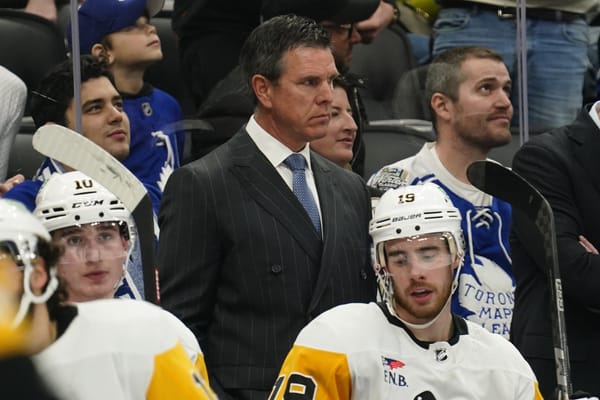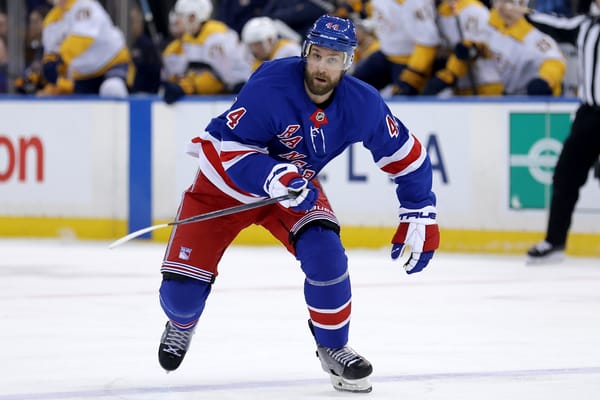Blueshirt Banter 2018 New York Rangers Prospect Rankings: 10-6
10. Alexandar Georgiev, Goaltender
2017 Ranking: 16
Age: 22
Acquired Via: Free Agency (2017)
Perhaps no player in the organization improved over the course of the 2017-2018 season more than Alexandar Georgiev. After signing Georgiev out of Finland with the intention of making him the starting goaltender in Hartford, he had an inconsistent start to the season. Through mid-January, he sported an unimpressive .891 save percentage in 24 games. However, Hartford was swiss cheese defensively, consistently conceding 35-40 shots and many dangerous scoring chances. Here is just a small taste of what he was subjected to on a nightly basis.
On Georgiev’s end, he had some immense performances where he was Hartford’s best player. I think back to a November stretch of four starts in six days where he averaged 36 shots against per game and nonetheless stood on his head, posting a .937 save percentage. In other showings where he was porous. Too many of the goals he gave up at times were low percentage in nature.
He eventually hit his stride in January, and it was just in time for a call-up on the heels of an injury to Ondrej Pavelec. The long-term nature of Pavelec’s injury, as well as the Rangers’ raising of the white flag on their season, meant that Georgiev got to make his NHL debut.
It was an absolute trial by fire, as over the course of 10 games Georgiev averaged 38.6 shots faced per 60 minutes. Even still, Georgiev stood tall. Based on expected goals as calculated by Corsica Hockey, Georgiev’s expected save percentage was .911 based on shot quality and volume faced. Instead, he performed above that number, posting a .918 save percentage for the Rangers. In his starts, he looked calm and confident in net despite the chaos going on in front of him. His tracking, as praised by Steve Valiquette multiple times, was on point, and for the most part the low-percentage goals that plagued him in Hartford were non-existent.
Though I liked Georgiev from the moment the Rangers signed him, over the course of a year he has been promoted from Just Another Prospect to someone who is now a serious contender to be a part of the Rangers’ long-term future.
His immediate future is also one of the most interesting storylines for the 2018-2019 season. There are very good reasons to make him Henrik Lundqvist’s backup, and also very good reasons to put him in the AHL next year. Perhaps the solution is somewhere in-between. I’ll do a more thorough breakdown of that debate somewhere closer to training camp.
9. Anthony DeAngelo, Right Defense
2017 Ranking: 4
Age: 23
Acquired Via: Trade (2017)
Disclaimer: As with last year, this is strictly an analysis of Anthony DeAngelo as a hockey player and his potential impact on winning hockey games. This is not a judgment of political views, existential morals, or anything else that is not specific to hockey playing ability.
If the 2017-2018 season had gone as hoped for DeAngelo, then he would not be on this list at all. He would have been considered a “graduated” prospect after having played a full season for the Rangers, racking up a bunch of points in the process.
That is not what happened.
DeAngelo did make the team out of training camp, beating out some heavy competition. That did not last long, as DeAngelo was sent to the AHL on October 24th after the Rangers began the season with just two wins in 11 games.
It was a low-effort attempt at fixing what was an intrinsically broken team. While DeAngelo wasn’t exactly a world beater, he did have a satisfactory start to the season. Through the team’s first 10 games of the season, he led all Rangers defensemen in Corsi For Percentage. The Rangers out-attempted the opposition at 80-63 with him on the ice at five-on-five. He was getting sheltered minutes, but nonetheless he was the least of the team’s problems.
Had DeAngelo dominated in the AHL, as one might expect he would have given his production the previous two seasons, it would have made his demotion look absolutely absurd. Instead, he looked pedestrian. He produced just seven five-on-five points (13 points overall) in 29 AHL games. He was not taking over shifts, and it’s not even as if he was creating opportunities that weren’t finished.
He was recalled to the Rangers in January, and an ankle sprain ended his season in March.
I am as big of a proponent of offensive defensemen as anyone. I have wasted way too many hours of my life defending the likes of Keith Yandle, Dan Boyle, and Kevin Shattenkirk on the basis that their defensive misgivings are well compensated and then some by their offensive outputs. So it does not bother me that DeAngelo is a bad defensive player.
But being an offensive defensemen means creating offense. DeAngelo did not do that in the NHL, where he produced eight points in 32 games, and just two points at even strength. He did not do it in the AHL either.
And look, he is not solely to blame here. The Rangers were a circus last year and, from the start, he was set up to fail. DeAngelo’s personality is one that requires stern, hands-on coaching every single day. Alain Vigneault is aloof and hands-off. It was a fundamentally disjointed pairing that was never going to work. Whatever his problems are, the Rangers did not set themselves up to work towards his strengths.
At the end of the day, though, this is DeAngelo’s third NHL team in three years, and he’s run out of any benefit of the doubt. Hesitantly, I am still ranking him in the top-10. On upside alone, he is a top-three prospect in the organization, and if Head Coach David Quinn and his staff and help DeAngelo replicate the form he has previously shown in both the AHL as well as with the Arizona Coyotes, then the Rangers will have a special player. With DeAngelo turning 23 in October, though, this may very well be his last shot.
8. Yegor Rykov, Left Defense
2017 Ranking: N/A
Age: 21
Acquired Via: Trade (2018)
(Written by European Correspondent Alex Nunn)
The Rangers acquired KHL defenseman Yegor Rykov from the Devils as part of the Michael Grabner trade at last season’s trading deadline. Although I’d have preferred for Rykov’s club role to increase beyond that of depth defenseman last season, it was always unrealistic to expect SKA to ruffle the feathers of an established blueline after their Cup-winning run. There’s still much to be said for continuing development with good minutes in a successful environment, and Rykov came out of 2017-18 with very few blotches on his record.
Following SKA’s earlier-than expected playoff exit, Rykov closed out his club season with SKA’s VHL affiliate Neva. He logged major minutes, including an eye-watering 61:19 as they edged the longest game in Russian hockey history at six overtime periods.
I look at Rykov and see someone perfectly capable of quietly anchoring a top-four defense pairing. He’ll rarely be a game-breaker, but Rykov is reliable and can be leaned on to eat up minutes in all situations while playing smart at both ends. He’s pretty cerebral in style with a strong frame, good wheels, accurate tape-to-tape distribution and consistent puck support tested against adults in the KHL since the age of 18. Teams need that kind of water-carrier to complement and cover its star blueliner, though make no mistake, Rykov can and will chip in with offense from time to time too.
7. Brett Howden, Center
2017 Ranking: N/A
Age: 20
Acquired Via: Trade (2018)
Though so much of coverage of the Ryan McDonagh and J.T. Miller trade centered around the acquisition of Libor Hájek, in my opinion Brett Howden is the better of the two prospects the Rangers received from Tampa Bay.
Howden is a pretty typical Western Canadian center. He is 6’3, though at roughly 190 pounds he has work to do to reach his physical potential. He has the power forward aspects to his game for sure. He uses his size along the perimeter, shielding the puck well and creating turnovers on the forecheck (watch for #21 in the following video). He also does most of his scoring above the crease.
Though I do think Howden will score a decent chunk of goals in pro hockey, he’s definitely a pass-first player, and creating chances for others is where the bulk of his offensive value lies.
Lias Andersson looks to be captain-in-waiting, but if you want to pick a dark horse, maybe it’s Brett Howden. He has earned a leadership role at many levels, becoming the Moose Jaw Warrior’s captain at 18. Internally, the Rangers are absolutely in love with Howden’s demeanor and presence, and they’ve gushed about it in public on a few occasions as well.
Generational talents aside, there are never any guarantees. Outside of Filip Chytil and Lias Andersson, though, I don’t think any Rangers’ prospect has a higher likelihood of carving out a lengthy NHL career than Brett Howden. What’s up in the air is whether he becomes a second-line center or a fourth-line center. I project him to land somewhere in-between. Looking at historical WHL players who are comparable in terms of style and production, I think an optimistic but realistic hope for Howden is that he carves out a career similar to Brooks Laich or Jarret Stoll. An elite third-line center who plays a physical game, covers his checks, gets used on the penalty kill, and chips in 35-45 points. That’s not a player you can build a franchise around, but it’s the type of player who can make or break a Cup contender.
6. K’Andre Miller, Left Defense
2017 Ranking: N/A
Age: 18
Acquired Via: 2018 Draft (First Round)
I covered Miller extensively in our draft rankings, and so I’m not going to reinvent the wheel. Here is a summary of that article, followed by some further analysis based on my findings in the month-plus since the Rangers selected him.
K’Andre Miller is physically gifted. He is a bit over 6’3 and roughly 200 pounds, and he uses his physical strength well. In the defensive zone, he engages with forwards, knocks players off the puck, and makes life difficult for forwards in the low slot. He also clearly has fast-twitch muscles, as he can explode up the ice and also reach an impressive cruising speed. With long strides, it doesn’t take very long for him to get where he wants. This makes him an asset on transition rushes, as he can quickly become the third rusher in a transition and also move down low to present himself as an option or create space in the high slot.
Defensively, he needs a lot of work still. He needs to get a feel for how to toe the line physically where it is an advantage but doesn’t earn him unnecessary penalties. And while he uses his size, speed, and reach proficiently as a one-on-one defender, particularly on zone entry attempts, he still is learning how to read plays and adjust positioning when it comes to five-man units in the defensive zone (or four-man units on penalty kills).
Mitch Brown of The Athletic tracked some live-game stats for a number of prospects in 2017-2018, and Miller ranked well across the board.
I do look at these numbers with a small dose of skepticism. Not because of anything wrong with Brown or his tracking methodology, but rather because of how loaded Team USA was last year. I wonder if there is some trickle down effect from projected 2019 first overall pick Jack Hughes, among others. Nonetheless, here are how teammates Bode Wilde and Mattias Samuelsson, both early second-round picks, measured.
Maybe Miller’s numbers were a bit inflated by how good the team was, but even still he measured out far better than most of his teammates.
Miller will be attending the University of Wisconsin, and I imagine the Rangers plan on letting him marinate in college hockey for a few years. He has such a unique skillset and is very raw. For those reasons, I’m not particularly comfortable boxing him into a certain typecast. He could end up an offensive defenseman, a defensive defenseman, or somewhere in-between. He could become a top-pairing guy or bottom-pairing depth. As a late-first rounder, Miller is an intriguing gamble on upside that will take a while to be realized, but which could manifest in a number of beneficial ways.




